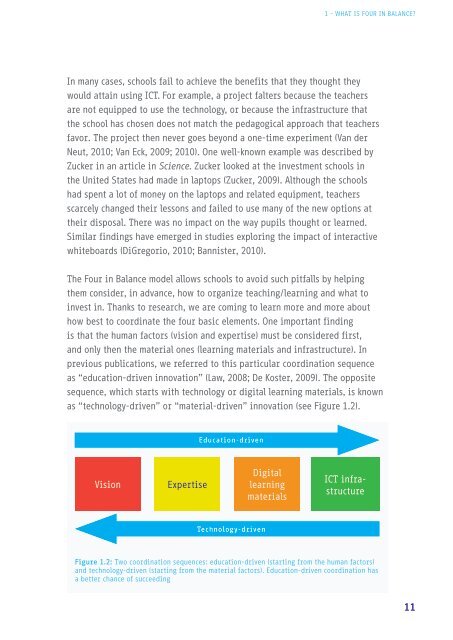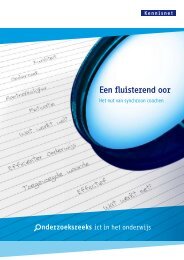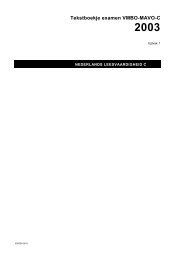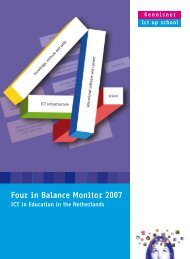Four in Balance Monitor 2011 - downloads.kennisn... - Kennisnet
Four in Balance Monitor 2011 - downloads.kennisn... - Kennisnet
Four in Balance Monitor 2011 - downloads.kennisn... - Kennisnet
You also want an ePaper? Increase the reach of your titles
YUMPU automatically turns print PDFs into web optimized ePapers that Google loves.
1 - WhAT IS FoUr IN BALANCE?<br />
In many cases, schools fail to achieve the benefits that they thought they<br />
would atta<strong>in</strong> us<strong>in</strong>g ICT. For example, a project falters because the teachers<br />
are not equipped to use the technology, or because the <strong>in</strong>frastructure that<br />
the school has chosen does not match the pedagogical approach that teachers<br />
favor. The project then never goes beyond a one-time experiment (Van der<br />
Neut, 2010; Van Eck, 2009; 2010). one well-known example was described by<br />
Zucker <strong>in</strong> an article <strong>in</strong> Science. Zucker looked at the <strong>in</strong>vestment schools <strong>in</strong><br />
the United States had made <strong>in</strong> laptops (Zucker, 2009). Although the schools<br />
had spent a lot of money on the laptops and related equipment, teachers<br />
scarcely changed their lessons and failed to use many of the new options at<br />
their disposal. There was no impact on the way pupils thought or learned.<br />
Similar f<strong>in</strong>d<strong>in</strong>gs have emerged <strong>in</strong> studies explor<strong>in</strong>g the impact of <strong>in</strong>teractive<br />
whiteboards (DiGregorio, 2010; Bannister, 2010).<br />
The <strong>Four</strong> <strong>in</strong> <strong>Balance</strong> model allows schools to avoid such pitfalls by help<strong>in</strong>g<br />
them consider, <strong>in</strong> advance, how to organize teach<strong>in</strong>g/learn<strong>in</strong>g and what to<br />
<strong>in</strong>vest <strong>in</strong>. Thanks to research, we are com<strong>in</strong>g to learn more and more about<br />
how best to coord<strong>in</strong>ate the four basic elements. one important f<strong>in</strong>d<strong>in</strong>g<br />
is that the human factors (vision and expertise) must be considered first,<br />
and only then the material ones (learn<strong>in</strong>g materials and <strong>in</strong>frastructure). In<br />
previous publications, we referred to this particular coord<strong>in</strong>ation sequence<br />
as “education-driven <strong>in</strong>novation” (Law, 2008; De Koster, 2009). The opposite<br />
sequence, which starts with technology or digital learn<strong>in</strong>g materials, is known<br />
as “technology-driven” or “material-driven” <strong>in</strong>novation (see Figure 1.2).<br />
Vision Expertise<br />
Education-driven<br />
Technology-driven<br />
Digital<br />
learn<strong>in</strong>g<br />
materials<br />
ICT <strong>in</strong>frastructure<br />
Figure 1.2: Two coord<strong>in</strong>ation sequences: education-driven (start<strong>in</strong>g from the human factors)<br />
and technology-driven (start<strong>in</strong>g from the material factors). Education-driven coord<strong>in</strong>ation has<br />
a better chance of succeed<strong>in</strong>g<br />
11








